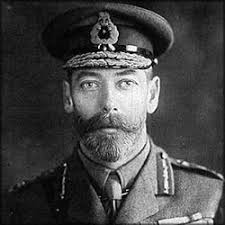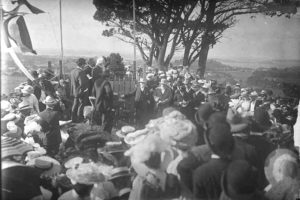1901: One Tree Hill
December 29, 2020
By AHNZ
 Statist History has not been kind to Auckland’s greatest benefactor and most prominent figure, The Father of Auckland, Dr John Logan Campbell. On 11 June, 1901, Campbell gave to New Zealanders some of his best land, One Tree Hill, a self-financing domain he named Cornwall Park. This arrangement also administered over the public land of the hill (Maungakiekie) itself and The Pioneer reserved only two things, a grave plot for himself on top of the hill and an even finer one for the Maori race itself.
Statist History has not been kind to Auckland’s greatest benefactor and most prominent figure, The Father of Auckland, Dr John Logan Campbell. On 11 June, 1901, Campbell gave to New Zealanders some of his best land, One Tree Hill, a self-financing domain he named Cornwall Park. This arrangement also administered over the public land of the hill (Maungakiekie) itself and The Pioneer reserved only two things, a grave plot for himself on top of the hill and an even finer one for the Maori race itself.
 Auckland’s Father was made temporary mayor of Auckland to match the stature of a State visit from the Duke of Cornwall (soon to be King George V) on his thank-you tour for New Zealand’s role in the Boer War. Campbell had been going to gift ‘Corinth Park’ to Auckland but revised his plans to honour the Duke and to be for all New Zealand not just the city¹.
Auckland’s Father was made temporary mayor of Auckland to match the stature of a State visit from the Duke of Cornwall (soon to be King George V) on his thank-you tour for New Zealand’s role in the Boer War. Campbell had been going to gift ‘Corinth Park’ to Auckland but revised his plans to honour the Duke and to be for all New Zealand not just the city¹.
Their Race Is Lost
When the good doctor first came to New Zealand he befriended the Maoris rather than the new Colonial Government being created up at Kororakia. When Governor Hobson’s Gang re-located their headquarters/capital to Auckland, Campbell was already there to sell products to them.
Campbell “…realized that, since the Maoris would long be ‘the dominant race’, his fortunes rested with them. For a time he went to live with a neighboring tribe, where he served his apprenticeship in the new land by helping to hollow out a canoe, and came to love his hosts.”- Sinclair
“Campbell’s will upon his death in 1912 provided abundantly for the upkeep of what is still Auckland’s most picturesque park, and for continued assistance to his many philanthropic interests.”- p387, NZH
Before the Maori race died out it had been evident for some time that the day would come. Campbell envisioned a memorial obelisk, with inscriptions, that would become a great landmark visible from either shore. Even today the only rival is the Skytower in the CBD.
“The Maori as a race must lose his purity and ultimately must be extinguished… though their race is lost, it has died hard, bravely and nobly.”- Ngata, Ref. 1892: The Past and Future of the Maori; AHNZ
“..these matters are at the root of the question and have a direct bearing not only upon the health of individuals, but upon the existence of the race,..”- Buck, Ref. 1906: The Maori Communistic System; AHNZ
“Disruption of the Maoris’ habitual patterns of diet added to the numbers who died early. They abandoned kumara gardening, fern grubbing, fowling and fishing in favor of flour, sugar and rotten maize and potatoes. Tobacco and alcohol wreaked their own havoc.”- p79, Cumberland
“I really do believe that the certainty of death will not prevent some of the natives from smoking for more than a given time. I have often seen infants refuse the mother’s breast, and cry for the pipe till it was given to them; and dying natives often ask for a pipe, and die smoking. I can clearly perceive that the young men of the present day are neither so tall, or stout, or strong, as men of the same age were when I first came to the country; and I believe that this smoking, from their infancy, is one of the chief causes of this decrease in strength and stature.”- Manning (1863)
“..the remembrance, of the great aboriginal race whose beautiful country passed away from them into the possession of the pakeha.”- Dr Campbell, letter to editor of NZ Herald (1903); Papers Past
Campbell’s memorial to the dearly departed Maoris was well under way when he died in 1912. Yet, his wishes were delayed and subverted in the years to follow.
In Memorandum
Following the announcement of 1901, Campbell formally gifted Cornwall Park to New Zealand and opened it on 26 August 1903 (image left.) He set it up as a self-financing trust so it wouldn’t need The State to run it. Unlike that other gift to all New Zealanders, The Waitangi National Trust, things are still going pretty well. The Trust, until recently, also looked after One Tree Hill Domain (Maungakiekie Hill) which is adjacent.
In 1904, Campbell then parted with the parts of his One Tree Hill estate that had not been gifted. He made a fortune in doing so, which goes to show the value of his gift in Cornwall Park. He was sorry to do it though, and with it went his pioneer hut called Acacia Cottage.
“Yet ‘not without some sentimental pangs…..I made the sale, but the urgency of wiping out the heavy mortgage on the estate dictated the necessity of putting the sentiment in my pocket along with the cash for the purchase money and let them fight it out together.”- Campbell in Stone (1987)
On Auckland Anniversary Day, 30 Jan 1907, a road was opened by Logan Campbell to the top of the hill in the Domain. This was the same year the Cavern of Bones was uncovered. The old man, now 90, was the first to drive to the top.
Two of his main points was that the monument would be a memorial to the departed race who once lived in Auckland and that he hoped the road would never close.
“…here where we now stand on Maungakiekie’s highest summit must be held sacred and tabooed, for here there must arise, towering heavenward, the mighty obelisk, a landmark from either shore, a Maori memorial for all time. This, I have already said, is a debt the people of New Zealand owe to the great aboriginal race whose country has passed into our hands, and is to us such a rich inheritance, a lasting memorial to the Maori people…”
“I ask you to join with me in the hope that; this beautiful carriage drive, giving access to the spot where we now stand, revealing this wonderful and magnificent panorama, may add to the attractions of our city, destined to become “the queen of cities in the South Seas.”- Campbell’s speech, Auckland Star (1907); Papers Past
Campbell would soon have his grave (1912) but the obelisk took until after World War II to emerge (24/4/1948) and when it did its meaning was blurred. As for the road, that is now lost to the public due to what happened next.
You Shall Not Pass
What was offered as a memorial has become re-imagined as a monument. When the Maoris died out the name ‘Maori’ became free and was picked up as a monica for the part-Maori, the hybrids still alive and well who identified as Maori. However, even this 1940s revisionism looks controversial to mainstreams historians today when the obelisk inscription reads…
“In 1840 the Treaty of Waitangi was signed whereby the Maoris accepted the sovereignty of the British Crown and were thereby secured in all their rights and privileges as British subjects.”
 It may be that even more inconvenient words, more in keeping with Campbell’s gift, have been stricken from the monument over the years. For example, what used to be on this little plaque (image right) facing the above text?
It may be that even more inconvenient words, more in keeping with Campbell’s gift, have been stricken from the monument over the years. For example, what used to be on this little plaque (image right) facing the above text?
“Volcanic cones susceptible to weeds and fire with livestock removed…Slightly more dramatic is the heightened fire risk on the dormant cones….There have been a number of fires on cones throughout history..”- Volcanic cones susceptible to weeds and fire with livestock removed; Stuff (2016)
 Sure enough, like other mountains in the TMC care (eg. Mt Wellington, eg Mangere Mountain. eg Mt Eden.) One Tree hill is now set to burn. The TMC and mainstream media will blame colonialism, specifically Guy Fawkes Day, even though New Zealand has been celebrating this for generations.
Sure enough, like other mountains in the TMC care (eg. Mt Wellington, eg Mangere Mountain. eg Mt Eden.) One Tree hill is now set to burn. The TMC and mainstream media will blame colonialism, specifically Guy Fawkes Day, even though New Zealand has been celebrating this for generations.—
1 Ref. An Encyclopaedia of New Zealand, A. H. McLintock (1966); Te Ara
2 You’d think a fire risk warning from a man with a name like that would get some attention…
Ref. p74, A History of New Zealand, Keith Sinclair (1959)
Ref. New Zealand’s Heritage (NZH)
Ref. Landmarks, Cumberland (1981)
Ref. Old New Zealand: Being Incidents of Native Customs and haracter in the Old Times by A Pakeha Maori, Manning (1863); NZETC, Victoria University
Ref. The Father and His Gift: John Logan Campbell’s Later Years, RCJ Stone (1987); What’s an SHA, and what’s it doing in my park?, Not PC (2015)
Image ref. Logan Campbell in Cornwall Park, Auckland Libraries Heritage Collections
Image ref. One Tree Hill a memorial to demise, Cumberland (1981)
Image ref. Campbell gifts Cornwall Park to all New Zealand; Auckland Libraries Heritage Collections
Image ref. You Shall No Pass sign; AHNZ Archives (2018)
 Like Comment Share
Like Comment Share








